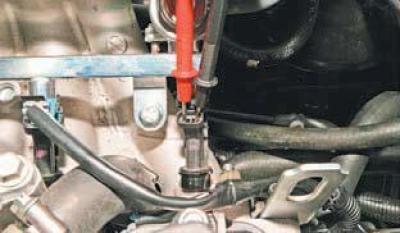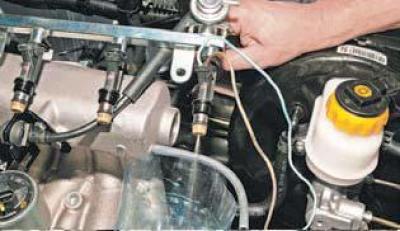We start checking the injector control circuits by checking the integrity of fuse F14 (15A) mounting block located in the cabin.
Failure of fuse F14 can also be caused by a malfunction in the generator circuits, vehicle speed sensor, canister purge valve, exhaust gas recirculation valve.
We replace the defective fuse with a new one, after checking if there is a short to ground on the front terminal of the fuse socket in the mounting block.
To check the supply circuits of injectors ("+" power) with the ignition off, disconnect the pads (4 things) injector wiring harness.
With the ignition on..

... we measure the voltage between terminal "1" and the "mass" of the engine for each injector.
The device should detect a voltage equal to the voltage of the car's on-board network.
We also check the health of the injector control circuits (open or short to ground) between terminal "2" of the wiring harness block of each injector and the output of the ECU harness block corresponding to each cylinder: 1st cylinder - terminal "M25"; 2nd cylinder - output "M22"; 3rd cylinder - output "M24"; 4th cylinder - output "M11".
To check the winding of the injector with the ignition off, disconnect the block of the wiring harness of the engine control system from it (see Removing the fuel rail and injectors).
By connecting the tester probes to the injector terminals..

... check the resistance of the winding.
For a working injector, the winding resistance should be 11.6–12.4 ohms.
To check the performance of the nozzle, the quality of the spray and the tightness of the sprayer, remove the fuel rail (see Removing the fuel rail and injectors).
We connect the tip of the discharge line pipe to the fitting of the ramp, and the tip of the drain line pipe to the nozzle of the fuel pressure regulator.
Install the fuel pump fuse.
We check each nozzle one by one, placing a container under it to collect fuel.
Turning on the ignition, with two wires we directly supply 12 V voltage from the battery to the injector terminals.
The operation to check the quality of fuel atomization with a nozzle is a fire hazard.
Avoid sparks when applying voltage to the injector.

Fuel jets with a characteristic spray cone should come out of the nozzle atomizer.
Having disconnected the wires from the nozzle, we check whether fuel flows through the holes of the nozzle sprayer.
Fuel leakage should not exceed one drop per minute.
Check the other injectors in the same way.
If the electrical resistance of the injector winding is not correct, the amount of injected fuel and the spray pattern are very different from those of other injectors, or the injector is leaking - it must be replaced.
